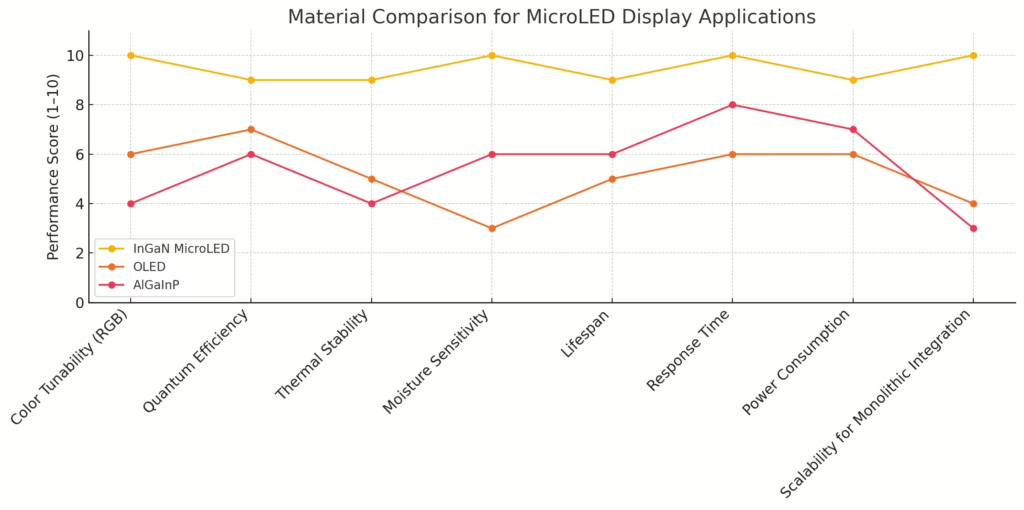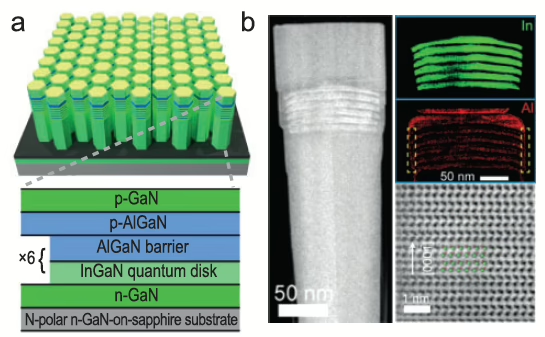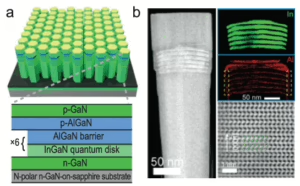In a world increasingly dominated by high-definition screens, from smartwatches to stadium displays, display technology is evolving fast, and the race is on to find the most powerful, scalable, and energy-efficient platform. Stepping into the spotlight are indium gallium nitride (InGaN) nanowire MicroLEDs, a next-generation display solution that could outshine LCDs, OLEDs, and even current MicroLED technologies. The science is simple: by carefully engineering InGaN nanowires, researchers can produce light-emitting diodes that are not only ultrabright and long-lasting but also tunable in color across the full RGB spectrum. Unlike traditional materials, InGaN allows for high pixel density, fast response times, thermal stability, and compactness, all of which are critical for cutting-edge applications in augmented and virtual reality, wearable tech, and high-performance video walls.

Researchers from South Korea’s Jeonbuk National University and VIT University in India examined the structural and optoelectronic challenges of scaling MicroLEDs into commercial use. They detail how InGaN nanowires, grown with advanced epitaxial techniques such as MOCVD and MBE, offer vertical architectures that boost light extraction and quantum efficiency. The research highlights how nanowire diameter affects indium content and, therefore, emission wavelength—making it possible to tailor RGB output with remarkable precision.
| Properties | LCD | OLED | QD-LED | MicroLED |
|---|---|---|---|---|
| Operating mechanism | Backlit | Self-emissive | Backlit/self-emissive | Self-emissive |
| Energy consumption | Medium | Medium | Low | Low |
| Pixel density | Up to 1000 PPI | Up to 2500 PPI | Up to 30 000 PPI | Up to 30 000 PPI |
| Brightness | <2000 cd m–2 | <1000 cd m–2 | >106 cd m–2 | >106 cd m–2 |
| Contrast ratio | 5000:1 | >10 000:1 | >1 000 000:1 | >1 000 000:1 |
| Lifetime | 30 000–60 000 h | <10 000 h | 1000–10 000 h | >100 000 h |
| Environmental stability | High | Medium | High | High |
| Moisture sensitivity | No | Yes | Yes | No |
| Flexibility | Low | High | Medium | Medium |
| Pixel size | Min. 32 µm | Min. 18 µm | Min. sub-micrometer | Min. sub-micrometer |
| Compactness | Low | Medium | High | High |
| Toxicity | Low | Low | High | Low |
| Operation temperature | −20 to 80°C | −50 to 70°C | −100 to 120°C | −100 to 120°C |
| Response time | Low (ms) | Medium (µs) | Very High (ns) | Very High (ns) |
| Visibility under sunlight | Medium | Medium | High | High |
| Cost | Low | Low | High | High |
The study dives into integration techniques such as selective area epitaxy and photonic crystal band engineering. These allow for higher brightness, narrower emission profiles, and improved light directionality without the heat and size limitations of earlier display types. Then there is the use of monolithic integration, where MicroLEDs and their driving electronics are grown together on a single wafer, addresses long-standing issues of power loss, size constraints, and pixel alignment errors. Experimental setups showed peak external quantum efficiencies of up to 25.2% and consistent emission wavelengths across a wide temperature range—a leap forward in display technology.

The research not only outlines the technical benefits but also underscores the commercial viability of nanowire-based integration methods. In particular, the ability to engineer entire RGB color arrays on a single chip, with high efficiency and low power draw, solves many of the core challenges facing OLEDs and traditional MicroLEDs. Ongoing obstacles, such as optimizing red-light emission and managing lattice mismatch-induced defects are a concern but the authors remain optimistic because innovations like photonic crystal engineering and controlled doping strategies are already showing strong potential to overcome these hurdles.
Reference
Vignesh Veeramuthu, Sung-Un Kim, Sang-Wook Lee, R Navamathavan, Bagavath Chandran, Dae-Young Um, Jeong-Kyun Oh, Min-Seok Lee, Yong-Ho Kim, Cheul-Ro Lee, Yong-Ho Ra, Scalable InGaN nanowire µ-LEDs: paving the way for next-generation display technology, National Science Review, Volume 12, Issue 1, January 2025, nwae306, https://doi.org/10.1093/nsr/nwae306

